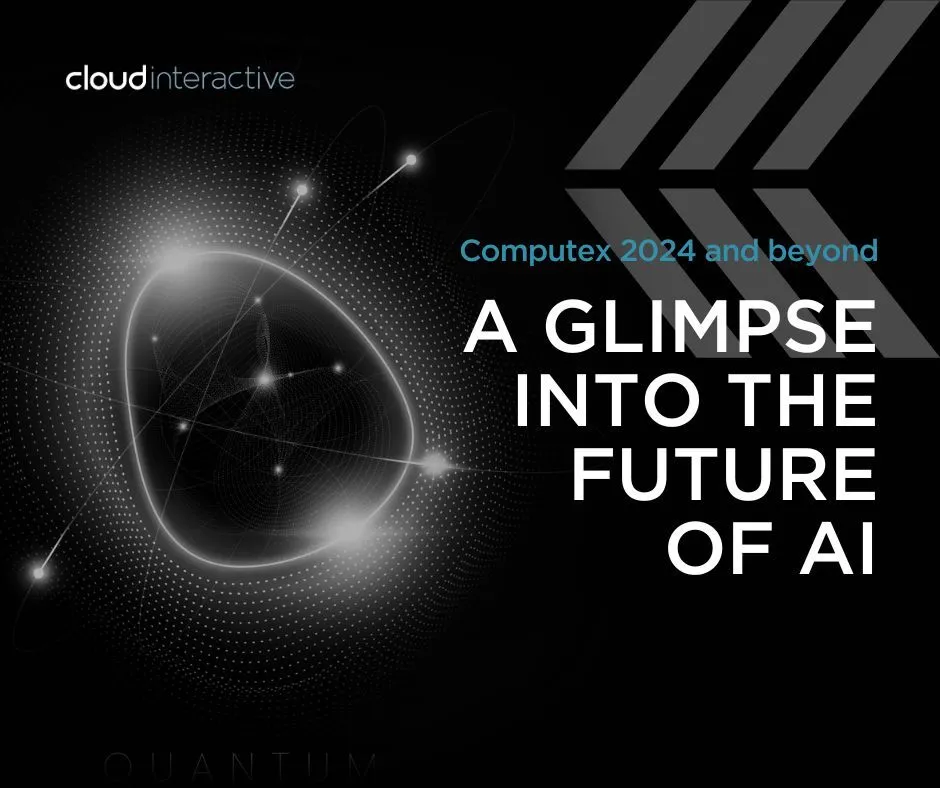
A Glimpse into the Future of AI
Explore the hottest trends shaping the future of AI, including environmental concerns, AI ecosystem, and cutting-edge hardware. Read more.
AI is no longer just about impressive algorithms and powerful machines. A key theme emerging from Computex 2024 is the growing focus on sustainable and collaborative AI development.
In this blog, we’ll delve into the hottest trends shaping the future of AI, exploring how industry leaders are tackling environmental concerns, fostering a thriving developer ecosystem, and harnessing cutting-edge hardware to revolutionize industries like healthcare, automotive, and manufacturing. Get ready to explore AI’s exciting – and sustainable – possibilities for the future!
Speakers references:
- Jensen Huang, CEO, NVIDIA
- Lisa Su, Chair and CEO, AMD
- Cristiano Amon, President & Chief Executive Officer, Qualcomm
- Pat Gelsinger, CEO, Intel
- Rick Tsai, Vice Chairman and CEO, MediaTek
- Charles Liang, President and CEO, Supermicro
- Lars Reger, EVP and CTO, NXP
- Tzi-cker Chiueh, General Director, Delta Research Center
Trend #1: Greening the Grid: Sustainability in AI
While AI offers incredible benefits for efficiency and progress, there’s a rising public concern about its environmental impact. Training and running complex AI models consume a lot of energy, leading to high carbon emissions.
A key highlight from this year’s Computex conference is the emphasis industry leaders are placing on developing high-performance AI solutions that are also environmentally friendly.
Here are some highlights at Computex 2024 shared by the industry giants:
- Nvidia is leading the next generation of AI advancements, focusing on reducing energy consumption and training costs. This allows for broader adoption and more efficient implementation of AI technology.
- AMD, under CEO Lisa Su, boasts impressive achievements in CO2 emission reduction. Their innovative chiplet-based architectures saved an estimated 50,000 metric tons of CO2e in 2023 (according to Tom’s Hardware).
- Intel focuses on performance-per-watt efficiency with its Xeon processors. This reduces the total cost of ownership for data centers and promotes more sustainable operation. This efficiency frees up server capacity for handling more AI tasks, contributing to a greener tech infrastructure
- Delta takes a holistic approach with their comprehensive data center solutions. Their focus is on energy efficiency and scalability, encompassing AI server power supplies, liquid cooling systems, and passive components. Their solutions focus on optimizing power delivery from the grid to the chip, addressing the high energy demands of AI data centers (Delta).
Trend #2: A Thriving AI Ecosystem
The success of AI is more than just dependent on powerful hardware or cutting-edge algorithms. A thriving AI ecosystem is the backbone of a successful AI future. By building strong partnerships, industry leaders can create a more efficient, sustainable, and developer-friendly environment. This, in turn, accelerates AI innovation and paves the way for widespread adoption across various sectors.
Removing barriers to AI development
NVIDIA takes a software-centric approach to ecosystem development. They’ve built a comprehensive suite of tools and libraries to empower AI developers. These tools streamline the development and deployment process, allowing developers to focus on creating groundbreaking applications. Here are some key highlights:
- CUDA-X Libraries: This collection offers optimized tools for various AI tasks, leveraging the power of NVIDIA’s GPUs. Developers can harness this power for tasks like image recognition, natural language processing, and scientific computing.
- NVIDIA NIM, a set of inference microservices, is now available to 28 million developers worldwide. It enables them to easily create generative AI applications that can be deployed on the cloud, in data centers, or on workstations.
By offering these tools, NVIDIA removes barriers for developers, fostering a more vibrant and productive AI development community.
Collaboration is Key
While NVIDIA focuses on software, AMD and Qualcomm, champion a collaborative approach. They actively partner with various stakeholders across the industry, including:
- Hardware Manufacturers: Collaboration with companies like HP, Lenovo, and Asus ensures that AI capabilities are seamlessly integrated into hardware platforms.
- Software Developers: Partnerships with Microsoft foster the development of AI-powered software applications, expanding the reach and impact of AI technology.
The Need for More Than Just AI
Reger from Intel pointed out that AI alone is insufficient to create an IoT or connected world. The entire brain of the connected machine needs to be reimagined. This includes everything from the power supply ICs at the bottom to the AI accelerators at the top.
A connected world cannot be achieved by a single nation but by the entire global ecosystem, including academies, governments, developers, and more.
Trend #3: Powering the Future: Advancements in Hardware
Processors with Dedicated AI Accelerators:
Chipmakers like Intel are developing processors with specialized hardware components to handle complex AI computations. These accelerators significantly improve processing speed and efficiency compared to traditional CPUs, such as Intel’s upcoming Arrow Lake and Lunar Lake processors.
Improved GPU Performance:
With NVIDIA’s GeForce RTX, AMD’s RDNA 3.5 architecture, and more, GPU architecture is leading to significant performance boosts for AI applications.
AI PCs
Gelsinger, Intel’s CEO, estimated AI PCs will take up 80% of the PC market. The rise of Neural Processing Units (NPUs) integrated into PCs is gaining traction, potentially boosting productivity and creativity through machine learning.
Trend #4 AI’s Next Big Moves: From Hospitals to Highways to Production Lines
The AI advancements in healthcare, automotive, and manufacturing were repeatedly highlighted in all keynotes. Here’s a closer look at how AI is changing these sectors:
Healthcare
- AI-Driven Diagnostics: AI tools are revolutionizing medical imaging and diagnostics. By analyzing complex medical scans with unparalleled accuracy, AI can lead to quicker and more precise diagnoses, improving patient outcomes.
- Drug Discovery Acceleration: Traditionally a lengthy and expensive process, drug discovery is being significantly accelerated by AI. AI simulates molecular interactions, pinpointing potential drug candidates faster and more efficiently.
Automotive
- Self-Driving Cars: AI is the engine driving the development of self-driving vehicles. Complex algorithms process information from various sensors, enabling autonomous cars to navigate challenging environments and improve road safety with features like automatic emergency braking. Intell mentioned one of the key challenges to overcome in self-driving cars is developing high-resolution radar sensors that accurately detect objects 250 meters away. This would allow Level 3 self-driving cars to operate at speeds of up to 130 km/h on German highways
- Smart Infrastructure: Integrating AI into traffic management systems can significantly reduce congestion and improve overall road safety.
- Advanced Driver-Assistance Systems (ADAS): AI enhances existing ADAS functionalities, like automatic emergency braking and lane departure warnings, leading to a safer driving experience for everyone.
- Predictive Maintenance: AI can analyze vehicle data to predict potential mechanical failures, allowing for preventative maintenance and minimizing downtime.
Manufacturing
- AI-powered Automation: AI-powered robots transform production lines by automating repetitive tasks, significantly enhancing efficiency and precision. NVIDIA and Qualcomm emphasized the integration of AI across their product lines.
- Predictive Maintenance: Like the automotive industry, AI can analyze machine data in manufacturing plants to predict potential breakdowns and schedule maintenance before they occur, minimizing production disruptions.
- Quality Control Revolution: AI vision systems scrutinize products on assembly lines in real time, detecting defects and anomalies with superior accuracy to human inspectors. This translates to higher quality standards and reduced waste.
- Supply Chain Optimization: AI can analyze vast amounts of data to forecast demand, manage inventory levels more effectively, and optimize logistics, leading to a more streamlined and cost-effective supply chain.
Summary: Everything Sense, Everything Connect, Everything Innovate
Imagine a future powered by AI, where progress is sustainable, achieved through collaboration, fueled by cutting-edge hardware, and built on a foundation of secure innovation. Leading tech companies are already shaping this exciting future. They’re forging extensive partnerships, inviting everyone and global enterprises to join the AI ecosystem. Powerful new tools and frameworks are on the horizon, designed to accelerate innovation, guarantee security, and unlock new levels of performance across all industries.
Cloud Interactive brings 14 years of extensive experience in large-scale software development. Our AI development services further enhance the ROI of critical business operations and position companies as integral players in a thriving, mutually beneficial ecosystem. By partnering with Cloud Interactive, businesses like yours can harness the power of AI to drive growth, innovation, and success in an ever-evolving digital landscape.
By Cloud Interactive
Meet the masterminds behind the curtain at Cloud Interactive. We're not just software developers - we're also a content crew fuelled by caffeine and a thirst for knowledge. We translate tech jargon into plain English, dissect industry trends, and craft helpful tips that are informative and engaging. So, buckle up and join us on a journey through the ever-evolving and exciting world of technology!


